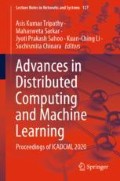Abstract
Intrusion refers to a set of attempts to compromise the confidentiality, integrity and availability (CIA) of the information system. Intrusion detection is the process of identifying such violations by analyzing the malicious attempts. Intrusion detection system is used to automate the intrusion detection process just in time or real-time and alert the system administrator for mitigating such efforts. Many researchers have been proposed several detection approaches in this context. In this paper, we adopt a semi-supervised learning-based support vector machine (SVM) approach for mitigating such malicious efforts. The proposed approach improves the learning process and the detection accuracy as compared to the standard SVM approach. Moreover, it requires less amount of labeled training data during the learning process. Our approach iteratively trains the labeled data, predicts the unlabeled data and further retrains the predicted instances. In this manner, it improves the training process and provides better result as compared to the standard SVM approach.
Access this chapter
Tax calculation will be finalised at checkout
Purchases are for personal use only
References
Allen J, Christie A, Fithen W, McHugh J, Pickel J (2000) State of the practice of intrusion detection technologies. Technical report, Carnegie-Mellon Software Engineering Institute, Pittsburgh, PA
Sahoo KS, Panda SK, Sahoo S, Sahoo B, Dash R (2019) Toward secure software-defined networks against distributed denial of service attack. J Supercomput 75(8):4829–4874
Rout JK, Bhoi SK, Panda SK (2014) Sftp: a secure and fault-tolerant paradigm against blackhole attack in manet. arXiv preprint arXiv:1403.0338
Saha M, Panda SK, Panigrahi S (2019) Distributed computing security: issues and challenges. In: Cyber security in parallel and distributed computing: concepts, techniques, applications and case studies, pp 129–138
1852 cyber attacks hit India each minute last year; Mumbai, Delhi most affected. https://www.securitytoday.in/indian-news/1852-cyber-attacks-hit-india-each-minute-last-year-mumbai-delhi-most-affected/. Accessed 30 Nov 2019
Ahmad I, Basheri M, Iqbal MJ, Rahim A (2018) Performance comparison of support vector machine, random forest, and extreme learning machine for intrusion detection. IEEE Access 6:33,789–33,795
Tao P, Sun Z, Sun Z (2018) An improved intrusion detection algorithm based on GA and SVM. IEEE Access 6:13,624–13,631
Ghugar U, Pradhan J, Bhoi SK, Sahoo RR, Panda SK (2018) Pl-ids: physical layer trust based intrusion detection system for wireless sensor networks. In J Inf Technol 10(4):489–494
Catania CA, Garino CG (2012) Automatic network intrusion detection: current techniques and open issues. Comput Electr Eng 38(5):1062–1072
Porras PA, Valdes A (2001) Network surveillance. US Patent 6,321,338
Chen W-H, Hsu S-H, Shen H-P(2005) Application of SVM and ANN for intrusion detection. Comput Oper Res 32(10):2617–2634
Eskin E, Arnold A, Prerau M, Portnoy L, Stolfo S (2002) A geometric framework for unsupervised anomaly detection. In: Applications of data mining in computer security. Springer, Berlin, pp 77–101
Liao H-J, Richard Lin C-H, Lin Y-C,Tung K-Y (2013) Intrusion detection system: a comprehensive review. J Network Comput Appl 36(1):16–24
Patcha A, Park J-M (2007) An overview of anomaly detection techniques: existing solutions and latest technological trends. Comput Networks 51(12):3448–3470
Tan P-N (2018) Introduction to data mining. Pearson Education India, Delhi
Chien C-H, Sun Y-M, Chang W-C, Chiang-Hsieh P-Y, Lee T-Y, Tsai W-C, Horng J-T, Tsou A-P, Huang H-D (2011) Identifying transcriptional start sites of human micrornas based on high-throughput sequencing data. Nucleic Acids Res 39(21):9345–9356
Maulik U, Chakraborty D (2011) A self-trained ensemble with semisupervised SVM: An application to pixel classification of remote sensing imagery. Pattern Recogn 44(3):615–623
Li Y, Guan C, Li H, Chin Z (2008) A self-training semi-supervised SVM algorithm and its application in an EEG-based brain computer interface speller system. Pattern Recogn Lett 29(9):1285–1294
Chang C-C, Lin C-J (2011) LIBSVM: a library for support vector machines. ACM Trans Intell Syst Technol (TIST) 2(3):27
KDD cup 1999 data. http://kdd.ics.uci.edu/databases/kddcup99/kddcup99.html. Accessed 30 Nov 2019
NSL-KDD dataset. http://nsl.cs.unb.ca/NSL-KDD/. Accessed 30 Nov 2019
Gurekddcup dataset. http://www.sc.ehu.es/acwaldap/. Accessed 30 Nov 2019
Author information
Authors and Affiliations
Corresponding author
Editor information
Editors and Affiliations
Rights and permissions
Copyright information
© 2021 The Editor(s) (if applicable) and The Author(s), under exclusive license to Springer Nature Singapore Pte Ltd.
About this paper
Cite this paper
Sahu, S.K., Mohapatra, D.P., Panda, S.K. (2021). A Self-trained Support Vector Machine Approach for Intrusion Detection. In: Tripathy, A., Sarkar, M., Sahoo, J., Li, KC., Chinara, S. (eds) Advances in Distributed Computing and Machine Learning. Lecture Notes in Networks and Systems, vol 127. Springer, Singapore. https://doi.org/10.1007/978-981-15-4218-3_38
Download citation
DOI: https://doi.org/10.1007/978-981-15-4218-3_38
Published:
Publisher Name: Springer, Singapore
Print ISBN: 978-981-15-4217-6
Online ISBN: 978-981-15-4218-3
eBook Packages: Intelligent Technologies and RoboticsIntelligent Technologies and Robotics (R0)

